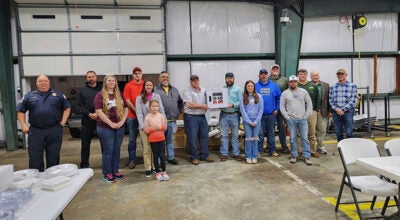Prairie solar farm proposed for Longview Drive
Published 6:35 pm Friday, February 10, 2023
|
Getting your Trinity Audio player ready...
|
Arlington-based Energix Renewables is proposing a 20-megawatt solar farm on 432 acres along Longview Drive.
The “Prairie Solar” facility, as the project has been named, would be located roughly two miles from the existing 180-acre Woodland solar farm, also on Longview Drive, which is at present the only operational solar farm in Isle of Wight County. Longview Drive, also known as State Route 602, spans roughly 6.3 miles from its intersection with Bowling Green Road near Darden’s Country Store to the Everets community on the Suffolk side of the city-county border.
Isle of Wight County’s agricultural/forestal district advisory committee voted 5-0 on Feb. 1 to approve a request by landowner Everets Properties Inc. to withdraw 103 acres from the Longview Agricultural/Forestal District for the Prairie project. Board of Supervisors liaison Don Rosie and four other members of the advisory committee were absent.
Agricultural/forestal districts are voluntary creations of county governments that allow landowners special land use rates when their properties are assessed for real estate taxes in exchange for a pledge to keep their land in agriculture, forestry or open-space use for a set number of years, usually 10.
Committee Chairman Brian Carroll described the vote as a “formality,” noting the committee has “no standing” to prohibit landowners from withdrawing their land from a district, since all had voluntarily entered their land in the first place.
The landowners would retain ownership under the proposed lease agreement with Prairie.
The committee’s vote is contingent on the project receiving a conditional-use permit. The requested permit is set to go before the county’s Planning Commission on Feb. 28 and would then need to secure final approval by the Board of Supervisors.
Following the committee meeting, Energix representatives hosted a public information session at Christian Home Baptist Church on Longview Drive.
According to Energix, of the 432 total acres, only 152 would have solar panels. The project site would be at least 600 feet from the road and surrounded by a 50-foot vegetative buffer.
The 20 megawatts produced would provide enough renewable energy to power over 5,000 homes for one year, and offset approximately 29,500 metric tons of carbon dioxide, a Prairie fact sheet states.
The Prairie project proposes to use American-made solar panels from Ohio-based First Solar. The panels would contain cadmium telluride, or CdTe.
Prairie is estimated to bring Isle of Wight County $4.5 million in revenue over the project’s 35-year lifespan from real estate and machinery and tools taxes.
Are CdTe panels safe?
According to a 2017 study published in the National Library of Medicine, CdTe is toxic to mammalian cells.
According to a frequently-asked-questions document by First Solar, these high-efficiency, thin-film CdTe modules deliver more usable energy per watt than conventional silicon-based solar panels. The modules would contain “very little” CdTe in the panels’ semiconductor layer, which would have a thickness roughly equivalent to 3% of the diameter of a human hair. CdTe is “insoluble in water” and remains stable even in high heat, which limits the potential for exposure.
The semiconductor layer would be encapsulated between two sheets of glass to limit the release into the environment in the event of fire or breakage.
The 2017 study, however, contends CdTe solar cells released 73% of their cadmium and 21% of their tellurium over 30 days when subjected to a Toxicity Characterization Leaching Procedure, or TCLP, which tests damaged and end-of-life panels to determine if they will leach toxic materials. The test, which simulated the acidic landfill phase of the panels’ life cycle, resulted in a cadmium concentration 650-fold higher than the maximum contaminant level set by the U.S. Environmental Protection Agency for drinking water.
First Solar’s FAQ document contends more than 50 researchers have confirmed the benefits and safety of thin-film technology over its life cycle, including normal operation, fires, breakages and end-of-life disposal. First Solar’s recycling process, the manufacturer contends, can recover more than 90% of a solar panel for reuse in new modules, so most of the material won’t end up in landfills.
Prairie Solar officials have also shared a 2019 study prepared for First Solar by Virginia Tech’s Virginia Center for Coal and Energy Research, which concluded CdTe panels “pose little to no risk under normal operating conditions and foreseeable accidents such as fire, breakage, and extreme weather events like tornadoes and hurricanes.”
While Woodland is Isle of Wight’s only operational solar farm, the county has approved a total of six facilities to date. A proposed Zuni-area solar farm known as Carver, if approved, would become the seventh, making Prairie, if approved, the eighth.




